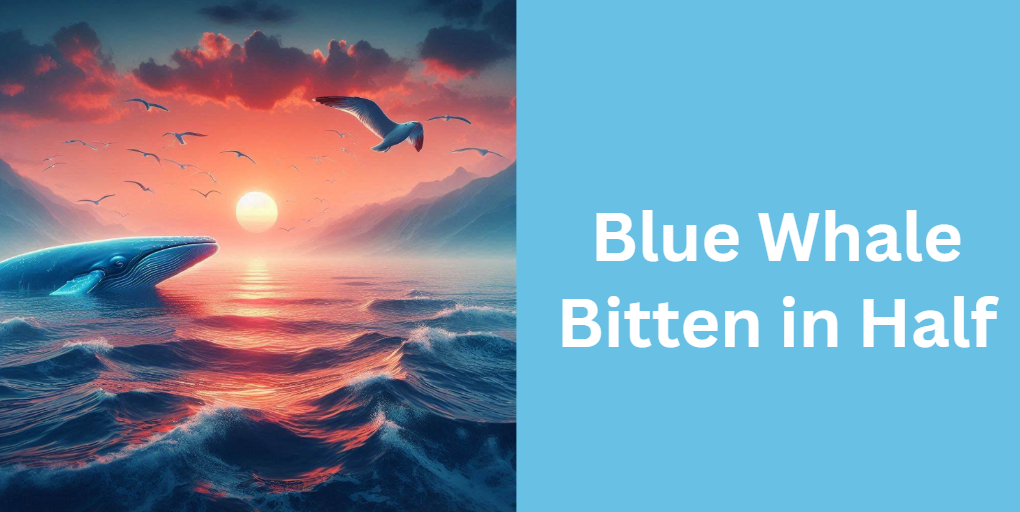The phrase “blue whale bitten in half” went viral after a mysterious incident caught global attention. People were shocked by the idea that the largest animal on Earth, the majestic blue whale, could suffer such a fate. This article dives deep into the mystery, examining the incident in detail, analyzing possible causes, and consulting expert opinions to separate fact from fiction.
Understanding what happened isn’t just about solving a mystery; it’s also a chance to learn more about the fascinating world of marine life and the natural challenges these giants face.
What Is a Blue Whale? Understanding the Largest Animal on Earth
Blue whales are the largest animals to ever exist on the planet, even bigger than dinosaurs. These gentle giants can reach up to 100 feet (30 meters) in length and weigh as much as 200 tons. They inhabit oceans worldwide, primarily in deep waters, and feed on tiny shrimp-like creatures called krill.
Key Characteristics of Blue Whales
- Length: Up to 100 feet (30 meters)
- Weight: Around 200 tons
- Diet: Krill (can consume up to 4 tons per day)
- Lifespan: 70 to 90 years
Despite their enormous size, blue whales have few natural predators. However, they can occasionally fall victim to orcas (killer whales) or suffer injuries from human activity like ship strikes.
The “Blue Whale Bitten in Half” Incident: What Really Happened?
The incident that sparked widespread curiosity occurred in 2021 near South Africa. A blue whale carcass washed ashore, showing significant bite marks that left experts puzzled. Photos and videos of the whale quickly went viral, leading to wild speculations about what could have caused such extensive injuries.
Some theories pointed to a great white shark attack, while others believed a pod of orcas might have been responsible. The size and severity of the bite marks made this case particularly intriguing.
Possible Causes and Theories Behind the Incident
1. Great White Shark Attack
The first theory suggests that a great white shark might be responsible. Great whites are known for their powerful bites and predatory nature, but attacking a fully grown blue whale is rare. While it’s possible that a large shark could bite parts of a blue whale, the idea that a shark could “bite it in half” is highly unlikely.
However, sharks are opportunistic feeders and might scavenge on a whale carcass that’s already dead or dying, which could explain the bite marks.
2. Orca (Killer Whale) Attack
Another plausible explanation is an attack by a pod of orcas. Orcas are highly intelligent predators known to hunt in groups and can take down large marine mammals, including young or weakened whales. Unlike sharks, orcas use strategic hunting tactics, targeting specific body parts to immobilize their prey.
Evidence Supporting the Orca Theory:
- Orcas have been observed attacking large whales.
- They often target the tongue and lower jaw area, which could match the injuries on the blue whale.
3. Natural Causes and Scavenging
While predators are the most obvious suspects, natural causes shouldn’t be ruled out. Blue whales can die from old age, disease, or injuries from ship strikes. After death, scavengers like sharks and other marine animals may feed on the carcass, leaving bite marks that appear as though the whale was “bitten in half.”
Expert Opinions and Scientific Analysis
Marine biologists and oceanographers have analyzed the photos and videos of the blue whale bitten in half incident. While they agree that the bite marks were severe, most experts lean towards the orca theory or natural scavenging rather than a single shark attack.
A forensic analysis of the bite patterns would provide the most conclusive evidence, but in the absence of detailed scientific studies, much of what’s known remains speculation based on past incidents and predator behavior.
How Rare Are Such Incidents?
Blue whales are rarely attacked by predators due to their size. However, incidents involving scavenging or predation on whale carcasses are not uncommon. Historically, orca attacks on large whales have been documented, but they mostly target calves or sick individuals.
Table: Common Causes of Blue Whale Injuries
| Cause | Description | Frequency | Severity |
|---|---|---|---|
| Orca Attack | Group attack on weak or young whales | Moderate | High |
| Shark Scavenging | Feeding on already dead whales | Common | Low to Moderate |
| Ship Strikes | Collision with large vessels | Increasing | High |
| Natural Death | Age, disease, or environmental factors | Rare | Moderate |
Misconceptions and Myths
The internet is full of sensational stories about the blue whale bitten in half. While it’s easy to believe dramatic headlines, it’s crucial to rely on verified information and scientific analysis. Myths about giant undiscovered sea monsters or super-sharks are entertaining, but they have no basis in reality.
The Importance of Marine Conservation
Incidents like this highlight the importance of protecting our oceans and marine life. Blue whales face numerous threats, including ship strikes, entanglement in fishing gear, and climate change. Conservation efforts are essential to ensure their survival and maintain the health of marine ecosystems.
Frequently Asked Questions (FAQ)
1. Can a shark really bite a blue whale in half?
No, it’s highly unlikely that a single shark could bite a blue whale in half. Sharks may feed on dead whales, but they don’t have the size or power to inflict such damage on a live whale.
2. Are orcas dangerous to blue whales?
Yes, orcas are known to attack blue whales, especially young or sick individuals. They hunt in pods and use sophisticated strategies to bring down large prey.
3. How can I help protect blue whales?
You can support organizations working on marine conservation, reduce your carbon footprint, and raise awareness about the importance of protecting marine life.
Conclusion
The mystery of the blue whale bitten in half continues to intrigue people worldwide. While theories range from great white sharks to orca attacks, the most likely explanation is a combination of natural causes and scavenging. Understanding these incidents helps us appreciate the complexity of marine life and the importance of conserving our oceans.
If you found this article informative, share it to raise awareness and protect these magnificent creatures!
Other Posts Like Blue Whale Bitten in Half
Bifenthrin 7.9 用量多少:Comprehensive Guide for Safe & Effective Use
MyOLSD: The Ultimate Guide to Olentangy Local School District Portal
MDL342 Controller: The Ultimate Guide to Features, Setup, and Applications





